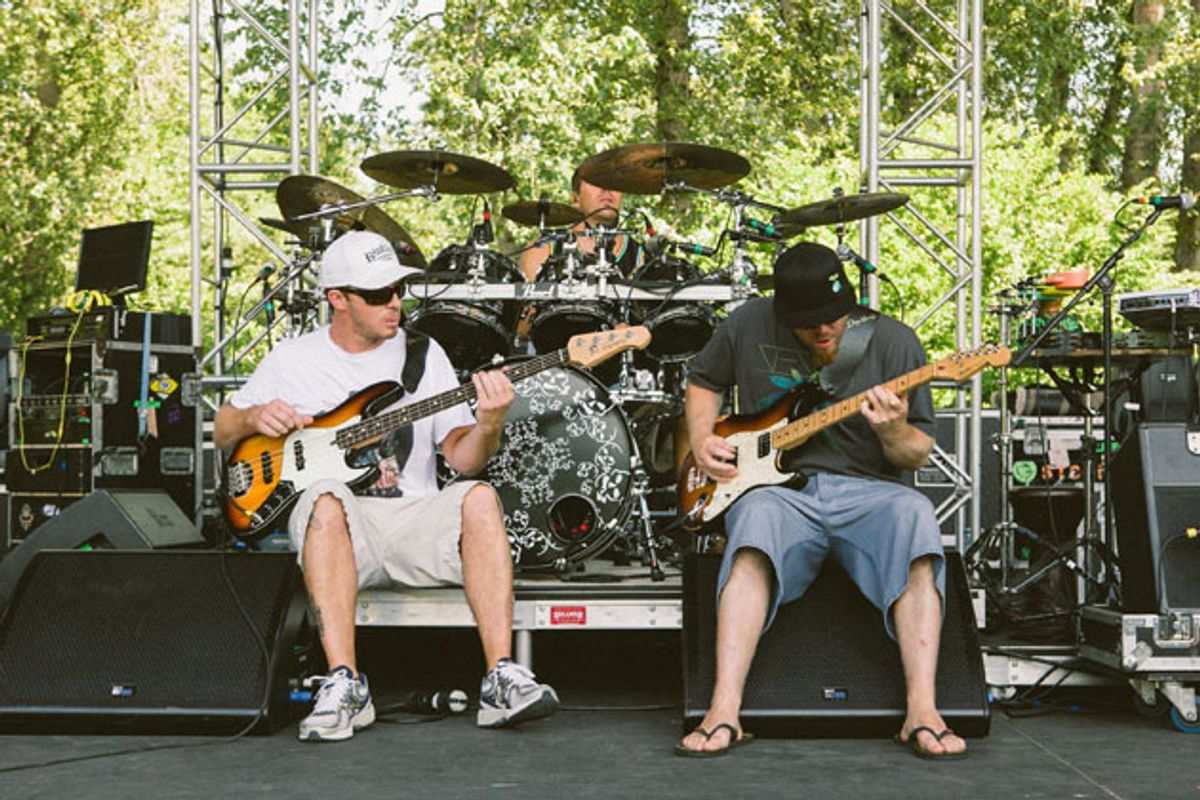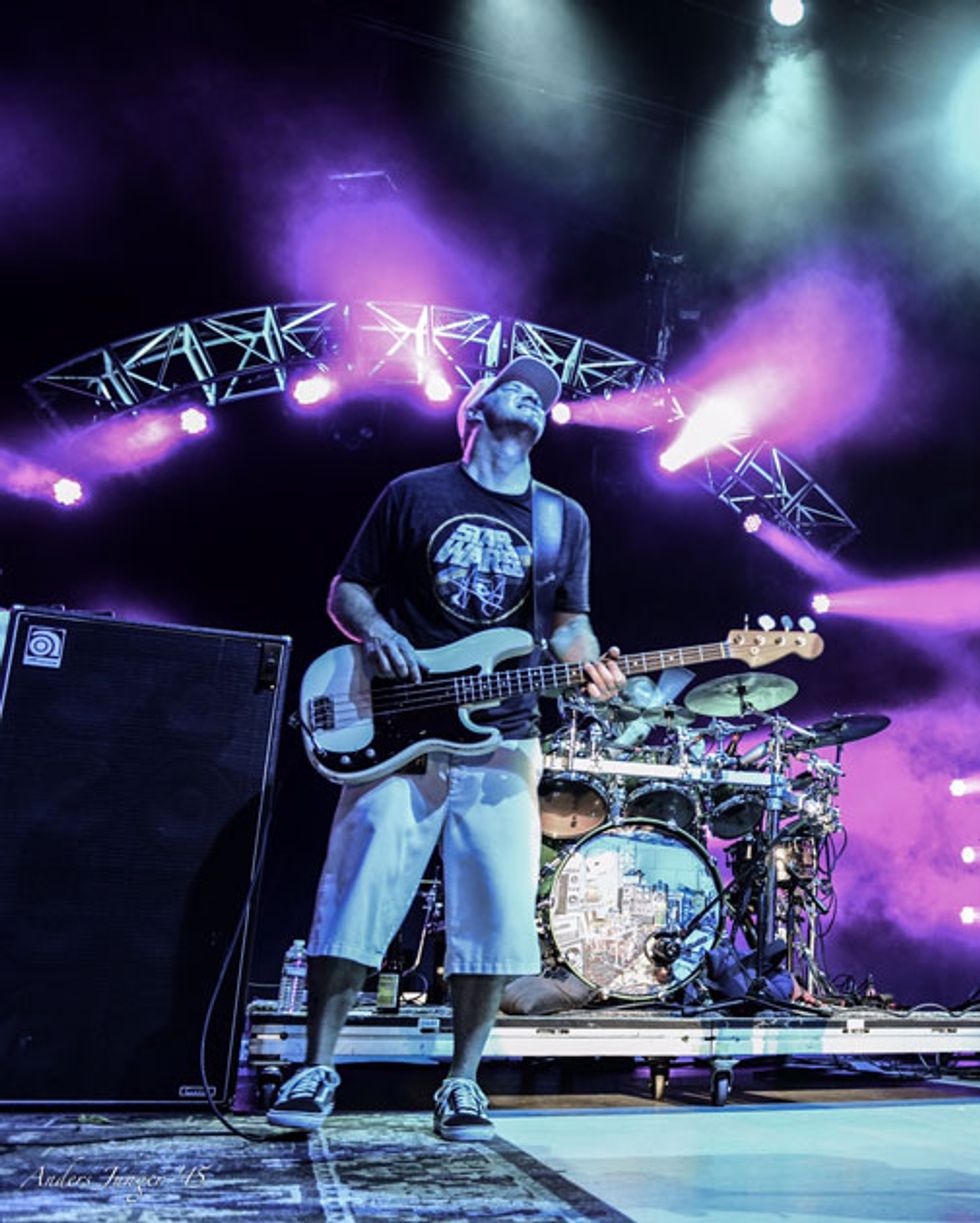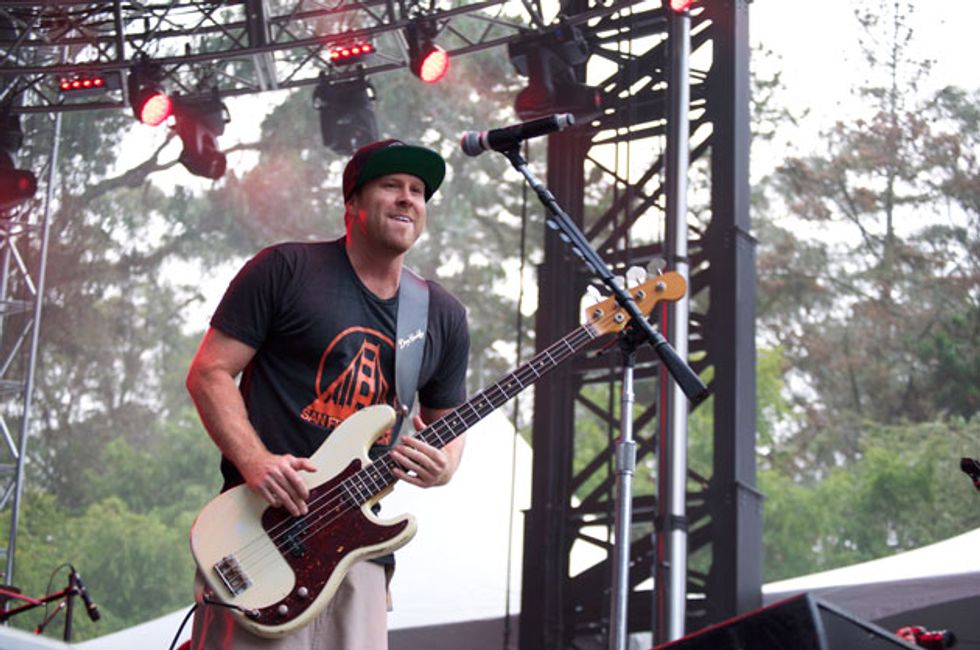
Whether laying down a bass groove or soloing on guitar, Miles Doughty and Kyle McDonald switch instruments seamlessly.
Most guitar players suffer from bass envy. They crave low-end mojo and want to be cool in that detached, understated, bass-player way.
On the other hand, some bass players are frustrated guitarists and long for glory and a chance to step out of the shadows. Well, maybe not out of the shadows, but at least for an opportunity to play above the 7th fret. In most cases you’re stuck with your instrument and the role you’re assigned.
Unless you’re in the band Slightly Stoopid. Founding members Kyle McDonald and Miles Doughty prove you can have it all. Both McDonald and Doughty play guitar and bass, and both players take each instrument seriously. They play bass like a bass player—with their fingers, sans pick—and weave endlessly groovable lines that sit deep in the pocket. But watch out: Either player can just as easily strap on a guitar, step up to the front of the stage, grab a pick, and add layers of color and madness like you’d expect a guitarist to do. And their transition between instruments is seamless.
McDonald and Doughty founded Slightly Stoopid in 1994. Back then, they were eager young San Diego teens, lived near the beach, surfed, played guitar, listened to music, went to shows, and were basically inseparable. “We’re brothers from other mothers,” Doughty says. “We’ve been around each other more than we have most of our family—because we’re always on the road together and whatnot—even growing up, we hung out every day when we were young.”
They were still in high school when they met Sublime frontman Bradley Nowell, who became a big brother, mentoring them and taking them under his wing. Under his guidance, Slightly Stoopid signed to Skunk Records, recorded their first album, hit the road, and built up a massive and loyal following for their infectious blend of punk-influenced reggae and groovable jams.
More than 20 years later and on the heels of their eighth studio release, Meanwhile…Back at the Lab, Slightly Stoopid haven’t stopped touring and show no signs of slowing down. “Most people can’t say they get to do what they love, travel around the world, uplift people through music, and uplift themselves every day,” McDonald says. “It’s a pretty big blessing.”
PG caught up with the duo to discuss their unique working relationship, the secrets of writing great bass parts, the deceptive simplicity of difficult reggae feels, their new custom Fader guitars and basses, and—in the spirit of their SoCal roots—glass guitars that double as bongs.
When did you first get interested in music?
Kyle McDonald: I’ve always been into music but what really got me into wanting to play music was Mötley Crüe, Guns N’ Roses, Metallica, Def Leppard—I think I was 9 or 10 when I got into those bands. Those were the kinds of bands that made me want to play guitar.
Miles Doughty: I started playing guitar around 12 years old. Kyle and I both started playing around the same time and it just took off from there. We started on the acoustic guitar and then slowly started to play the electric. We started a band in high school. Obviously, we’re still doing it.
How did you meet up with the guys from Sublime?
Doughty: We met them when we were young at a show in San Diego. It was at this place called Green Street. My mom had convinced Brad [Nowell], Miguel [Michael Happoldt], and Brad’s girlfriend to come back to the house the next day—my mom was pretty convincing back in the day. We had guitars and a 4-track set up, started jamming, and became buds. I was just a kid but Brad took on that big brother role and came down and jammed. I would cruise up to Long Beach and cruise with all the guys and go to the shows. I was a 16-year-old hanging out with all these cats and it was pretty rad man. It was a whole experience.
What did you learn from them about playing and recording?
McDonald: We learned from them to take it on the road. No matter how many records you have out or how great a record is, you have to take it to the road, tour, and be a road dog. It will take about five years from the time you start to get anything off the ground. We’ve seen people that have been coming out to shows for almost 20 years now. We see them every year, they’re like family to us.
You both play guitar and bass, which is unusual. Why is that?
McDonald: I think it’s a little easier to sing and play the guitar than it is to sing and play the bass. We do a little bit of both, but for the most part, the guy who is singing has the guitar.
Is it obvious who is going to play guitar and who will play bass on a particular song? Do you ever have to fight it out?
Doughty: No. Usually if I write something on guitar, I play it on guitar. If Kyle writes something on guitar, he plays it on guitar. There’s no fight about it. If he has ideas about what he wants to do for a bass line for the song, I just learn what he wants to play. And vice versa. If we have different ideas about what we want to hear on bass, we both just learn what the other guy wants to hear and make it happen within the music.
McDonald: Really it’s just whatever is more natural. We feel it out.
Both of you play the bass with your fingers but use a pick for guitar. Why is that?
Doughty: That’s the sound you want on the bass. You don’t want to play the bass with a pick if you’re playing reggae, blues, funk, and all that stuff. You’re not supposed to use a pick. You need that warmth from the fingers.
Most guitarists are horrible bass players—they overplay and their tone is lacking. How do you switch hats so quickly when you take on the bass role?
Doughty: It’s just the vibe that you have to pick for each song. Obviously, as a guitar player you always want to add extra stuff. When you’re playing bass you have to be with the feel of the drums and of the other instruments onstage.
McDonald: I think if the drums are cracking and you have a really strong foundation of a drum beat—that’s what the bass line revolves around. Also, less is more. You have to know where not to play. Where you do play, keep it bubbly or keep it according to that beat. If the heartbeat is solid and strong, then the song will be too. The beat and the foundation—you just keep the bass revolved around that.
Slightly Stoopid’s Miles Doughty is shown here playing a custom Fader bass that’s chambered to give it a woodier sound, make it rounder, and feel lighter. It also features an onboard preamp. Photo courtesy of Miles Doughty
When you switch instruments, the bass player moves to the “bass spot” onstage, too. Why is that?
Doughty: I like to stand right in front of the kick drum. You get to feel all the subs and the side fills. We have two 8x10 cabs on the side of the drums, so it gets that full, round feel.
McDonald: Sometimes the stage resonates in different areas and if you stand on what we call the hot spot—it’s the fucking sweet spot—it just rumbles bigger. It rumbles up through you. It feels good.
Slightly Stoopid’s Gear
Guitars and Basses
Assorted Fender Strats
Taylor T5
Taylor 814ce
Assorted Lakland basses
Fader P-style custom bass with onboard preamp
Fader modified Jazzmaster-style body with two P-90 pickups and a stealth humbucker mounted under the pickguard
Guitar Amps
Mesa/Boogie Dual Rectifier Head through 4x12 cab
Mesa/Boogie Lonestar Head through 4x12 cab
Fender Twin Reverb 2x12 combo
Bass Amp
Aguilar DB 751 Head through 8x10 Ampeg cab
Guitar Pedalboard
Electro-Harmonix Holy Grail Reverb Nano
Boss PH-2 Super Phaser
Boss DD-3 Digital Delay (two)
Ibanez Tube Screamer
Boss Giga Delay DD-20
Fulltone OCD
Morley Steve Vai Bad Horsie 2 Electro-Optical Contour Wah Pedal
Boss TU-2 Chromatic Tuner
Voodoo Lab Amp Selector
Bass Pedalboard
Boss TU-2 Chromatic Tuner
MXR Bass Envelope Filter
Dunlop Uni-Vibe Jimi Hendrix 70th Anniversary
MXR Carbon Copy Analog Delay
Mesa/Boogie Flux-Drive
Mesa/Boogie Tone-Burst
Mesa/Boogie Grid Slammer
Dunlop Cry Baby Wah
Picks and Strings
Dunlop picks 1.00 mm
.012 sets for both electric and acoustic guitar
How does your relationship with the rest of the band change when you’re playing bass as opposed to guitar?
McDonald: When I’m playing bass I try to keep it locked and tight and grooving. When I’m on the guitar there is a little more freedom. That’s where I let loose a little bit.
Doughty: The role of bass is to create that pocket with the drums, so any vocal, piano, horn line, or guitar can drop in there. You need that to keep the song going—it carries everything. If you’re playing something funky and fast, the bass is going to be a little busier. If you’re playing slower and more laid back, it’s going to be less notes and more locked in the pocket.
How about rhythm guitar? In such a large band, do you sometimes find you’re competing with the keyboards? How do you control the clutter?
Doughty: Sometimes you just stop playing guitar. We’ll stop, let the keyboard play, and concentrate on the vocals. When you’re not singing—bring the guitar back in. And obviously, when you’re playing something like reggae, you don’t want to be competing the whole time—like doing skanks at the same time—so you do different things, whether it’s doing shadow guitars or little licks.
McDonald: Silence is golden, I always say. Some of the best musicians know when to drop out, come back in, do air breaks, little pauses, and stops, and fills—it’s just a feeling—little formulas of when to cut in and cut out. It goes a long way.
What advice can you give younger players trying to learn how to play a reggae or ska feel?
Doughty: You need to do your homework by listening to reggae music in general. It isn’t as easy as everyone thinks. A lot of people do the upstroke for the reggae rhythm because they can’t understand the way that you hear it. Sometimes it can’t be taught if you don’t have the feel—not everyone is going to be able to do it. But I think that sticking to your guns, always practicing, and not being lazy—you’re going to break through regardless. And what’s cool about today is that you can pull anything up on YouTube. You can watch the whole technique of it.
Playing a funk groove or a reggae feel is a lot harder than it looks.
Doughty: It is a feel and it’s not as easy as everyone thinks. But also it’s not as hard if you understand what’s going on in the music. That’s why I say you have to do your homework with some of the old-school players. Sly and Robbie is a great way to start. A lot of people’s first choice is Bob Marley—he’s the most recognizable reggae musician. But there are also amazing cats like Don Carlos, Yellowman, Toots and the Maytals, Desmond Dekker—stuff like that should be studied. That’s how you learn how to play.
Why do you use the same guitars and pedals instead of having separate setups?
McDonald: We’ve tried to do that before, but it gets to be a little too much. For us it’s easier just to have one dope guitar setup and one dope bass setup. Keep it simple and make sure each one is sounding solid.
Doughty: We do so much touring—it’s easier in the long run of the madness of shows. We use the same pedals anyway so we just get a board big enough to fit the pedals that we want.
Does sharing equipment ever create problems onstage?
Doughty: Sometimes we’ll have certain guitars we want to play and they’ll get mismatched while trying to do switches. And sometimes we’ll go into a song and the pedals will still be on from the last song—that first note will be like every little sound that was going on from the last song. Sometimes that happens onstage, but it’s an easy fix.
You feature a lot of acoustic guitar on your albums. Why don’t you use it much live?
Doughty: It’s easier to use it in the studio. We have such a loud stage volume—we like to have our own show onstage aside from the show that’s going on in front of the house—that way we can feel what the crowd is feeling. When you have it that loud, the volume, no matter what you do, rattles the acoustic strings and you can’t play it cleanly.
But you break it up more in the studio.
Doughty: Yeah. A lot of the reggae songs sound good when you add acoustic rhythms to them.
Acoustic has one of the greatest tones. There’s something the electric can’t get that acoustic has. It’s fun to use it in the studio.
How do you mic the acoustics when you’re recording them?
Doughty: We plug them in direct and we mic them. We don’t have a booth [in our studio], we have rooms we like to record in.
McDonald: Our studio is like a big playground full of stuff. A whole wall is lined up with guitars, basses, and an array of different amps we use. I don’t like to be pigeonholed into using one thing.
Do you have any interesting guitars?
McDonald: A fan of ours blows these glass guitars: The glass is hollow and you can hook a bowl up to it and smoke through the guitar. It’s the most beautiful guitar I’ve ever seen in my life and it plays like butter. It sounds amazing whether it’s plugged in or not and it’s some killer craftsmanship.
Where do you see yourselves in the future?
McDonald: I just take it one day at a time. We really don’t know any better than what we’re doing. We’ve had our fair share of day jobs and we’re grateful to be able to play music and travel around. We know we’re really lucky.
“When I’m playing bass I try to keep it locked and tight and grooving,” Kyle McDonald says. “When I’m on the guitar there is a little more freedom.” Photo by Rich Osweiler
A Custom Affair
Slightly Stoopid recently added two new instruments to their arsenal of touring gear: a Fader Custom guitar and bass. They’re particularly enamored with the bass. “It’s so warm and round and every note is just crisp and clear,” says Miles Doughty. Kyle McDonald agrees. “It doesn’t feel like you’re holding a big thing and it’s super light,” he adds. “You can move around a lot more and it really brings the tones out.”
Fader Custom guitars and basses are one-of-a-kind instruments built by Craig Welsch in Boston. “Being a sound engineer, I’m obviously into detail and tone,” says Welsch. “Those two things helped me construct guitars that would do the things I needed them to do in the studio.” It doesn’t hurt that the studio he works at—Boston’s Rear Window Studio—is stocked to the rafters with vintage gear. “I analyzed those instruments and saw what was making them work—the woods, the necks, the hardware—there’s a charm to the old hardware that is considered by many to be cheap hardware. It’s very thin. It’s cheap. But it vibrates. When you get into all this newer hardware that is supposed to be high mass and all that stuff, it suffocates some of the charm of what those instruments do.”
Welsch was Slightly Stoopid’s front-of-house engineer for four years in the late 2000s. “I learned all the things they would struggle with night after night,” he says. “One of them being that the bass never quite had definition, it seemed it was the wrong kind of bass. I designed an instrument for them to be chambered to give it a woodier sound, make it rounder, and to lighten the load on their shoulders. I put a preamp inside of it—it’s basically a notching filter type of thing, like an old API EQ, and you can boost or cut at different frequencies. I shaped that around what they were going for. A lot of the old reggae lines play on the D and G strings and they want those strings to still be round and have low end.”
The guitar is unconventional as well. It has Jazzmaster-style body but a unique pickup configuration, with two P-90 pickups (neck and bridge) and a humbucker in the middle, hidden underneath the pickguard. “It has all of the positions of a Les Paul and then the two great Stratocaster sounds, those being the out-of-phase sounds in the second and fourth switch positions,” Welsch says.
“I designed those instruments specifically with them in mind,” he adds. “Meaning two guys who switch between bass and guitar during the show a lot. Kyle liked one sound and Miles liked another, and they had to find happy mediums.” Even the strap length had to be discussed. “When you throw a guy a guitar, he’s got to be able to play it.”



